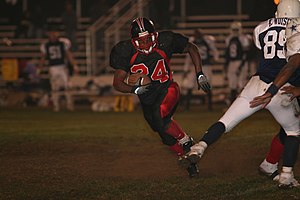Soccer and football cleats may look a lot alike and their purpose is the same. These shoes provide the athlete with both stability and traction while on the playing field. Although they may look alike, there are some differences, which mean one pair of cleats cannot be worn for the same sport.
Below are some key differences you should take into consideration:
- Design. Football cleats come in three profiles, low-cut, mid-cut and high tops. High tops are preferred by the players who do a lot of lateral movement. Low-cut or mid-cut shoes are worn by players who require increased maneuverability such as running backs and wide receivers. Soccer cleats are only made in low-cut style because not only are they lighter weight, but they also allow for greater speed and agility on the playing surface.
- Product. Both soccer and football cleats are constructed from hard plastic and can be detachable. Soccer cleats have the option of an aluminum cap that allows for greater traction. Aluminum caps are not allowed on football cleats. Soccer also allows a metal spike in some instances, which is never allowed in football. One feature present in football cleats that is lacking in soccer cleats is the presence of a horizontal toe spike. The function is to help dig in and provide front driven support. Another horizontal mid-sole spike provides traction against fast starts.
- Manufacturer. Most major manufacturers of sports shoes make both football and soccer shoes. You should know the rules governing the shoes for your particular league. For instance, although one inch cleats are manufactured, not all levels of football allow them. Check with the team coach for added specific information governing shoes and take a features list with you when you go shopping.
 |
| (Photo credit: Wikipedia) |
References:
http://www.livestrong.com/article/111722-difference-between-soccer-football/




Great information, it's hard to believe school is almost here again.
ReplyDeleteThanks and too true Dr. Gauntt. This summer has flown by super fast!
Delete